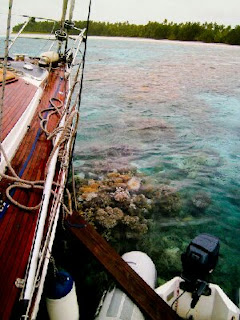If you look at Google Earth and zoom in on Boddam Island in Salomon atoll in the Chagos Archipelago you'll noticed a labyrinthine maze of coral reefs, rocks and bommies. The 48' Wauquiez, P. had been blown into the thickest concentration of this coral—a feat so unlikely that charts, Google Earth and swimmers couldn't agree on a clear path to get them back out.
Before the boat could be recovered though, it had to endure a tide cycle. At 4am, when the mooring broke, the tide was midway through the ebb. Squalls were still on the horizon so the first step was to keep the boat from being pushed further onto the reef if the winds picked up. Using dinghies and divers, two anchors were positioned upwind of to keep the boat stable and then tires and a fenderboard were placed under the keel and hull to protect it from being battered as the tide fell.
Fortunately the weather held, and with the boat stabilized the guys began to check the boat for damage. The hull was intact but the rudder appeared badly damaged and the propeller shaft was bent. This meant the boat wouldn't be able to motor free under its own power without risking significant engine damage. The wheel was also difficult to move so whether or not it would be able to steer was still to be seen.
As the tide began to rise the boat crews struggled to come up with a plan to get the boat free. It looked like there were two possible routes out—so divers explored each option and then marked them with buoys, to see how they each looked from the perspective of the boat. The challenge was neither path was entirely clear. In both cases the boat would be required to make multiple sharp turns; a move that would be difficult under normal conditions but almost impossible with a damaged rudder and a bent propeller shaft.
The initial plan was to use several dinghies in unison as tugs and tows, but almost immediately that plan failed. There simply wasn't enough room between the boat and the reef to fit a single dinghy, let alone several.
The new plan was to go with old-school anchor warping. What this meant was a diver would swim forward along the longest clear path they could find and then have an anchor given to them to place on the bottom—then on deck the anchor rode was pulled in by hand, inching the boat forward, while a stern anchor was eased out to control the swing of the boat. When the boat reached the bow anchor, this became the new stern anchor and then the old stern anchor was hauled up and placed ahead of the boat by the diver.
Using this laborious technique, the boat was moved a few cautious feet at a time over the course of several hours. Two or three divers were in the water the whole time, edging the boat through schools of sharks, around coral and easing it over shallow patches. As the day went on, we kept a cautious eye on the weather—nervous that a single squall could undo hours of work.
Twelve hours after the boat went aground it was securely at anchor and the entire anchorage was giddy with the thrill of the rescue. The sober truth is there are the wrecks of at least three boats in this anchorage and we'd been perilously close to adding a fourth. While we celebrated we knew there was still work to do so we hit the beach for sundowners and began to strategize over part two: how to repair a badly damaged rudder and prop shaft in the middle of nowhere.
This e-mail was delivered via satellite phone using Iridium Mail & Web software. Please be kind and keep your replies short.
June 4, 2015
Aground! The recovery
Subscribe to:
Post Comments (Atom)


1 comment:
We were in Chagos in 1990, when an out-of-season, and unpredicted, storm with cyclone-force winds swept through the area. Fortunately, we were on our own anchors, and only drug a bit until our Bruce anchor embedded itself into a coral bommie. I know that this is frowned upon now, with cruisers being more aware of the damage this does to coral, but back then we were thankful to have that keep us from dragging.
Unfortunately, another cruiser was not so lucky. That boat drug and could not get reanchored and was motoring through the anchorage in 55 kt winds. My dad swam to this boat in the middle of the storm and helped them get reanchored and stayed with them until the storm abatted.
The cruising family is indeed a tight-knit community. I look forward to hearing more about this story. I have no doubt that by putting your collective heads together, you'll come up with something to get this stricken boat to a port where they can make repairs.
Post a Comment